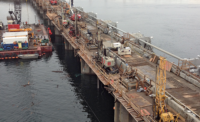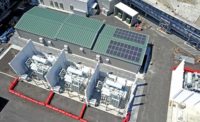Goodnoe Hills Wind Project
Goldendale, Wash.
Best Project
Owner: PacifiCorp.
Lead Design Firm/Structural Engineer: Black & Veatch
General Contractor: IEA Constructors LLC
Civil Engineer: Kimley-Horn
MEP Engineer: Atwell
Turbine Supplier: Vestas-American Wind Energy Inc.
Subcontractors: Westwood Engineering; JMS Wind Energy Inc.; Herling; Hood River Concrete
Repowering the Goodnoe Hills Wind Project required IEA Constructors to merge new technology with old, upgrading the wind farm along the way.
Originally built in May 2008, the site had for the past 11 years used 47 Senvion MM92 2.0-MW wind turbines with a nameplate capacity of 94 MW. But as the need for energy increased, Goodnoe Hills offered itself as a candidate for repowering with higher-capacity generators and larger blades as a cost-effective way to increase renewable energy without expanding the farm’s footprint.
IEA Constructors, working with Black & Veatch, used 47 new V110-2.2 turbines with 23-ft tower adapter sections to place new equipment on the existing towers, increasing the megawatt nameplate capacity to 103. But to accommodate the higher structural loading needed for larger equipment, the site required significant foundation upgrades—without increasing the less than half-acre of ground per tower in an area already dense with wind farms. The foundations were engineered and installed for the new turbine loads while a partial operation of the Goodnoe Hills wind project continued.
IEA Constructors removed the old turbine equipment and installed new tower adapters, nacelles, hubs and rotors supplied by Vestas. During the process, the Senvion tower tops and new Vestas turbine nacelles were found to be incompatible; a new 23-ft tower adapter section was engineered and manufactured to make the existing towers fit with the new equipment.
To minimize waste, the Goodnoe Hills team hired a contractor to help recycle turbine generators and gear boxes for use as spare parts in neighboring wind farms while establishing recycling and repurposing programs for future repowering projects. The project finished in December 2019, on time and within budget, with a 25% increase in energy output.






Post a comment to this article
Report Abusive Comment